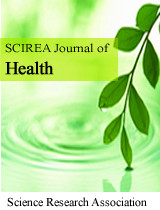Applying the Theory of Planned Behavior to childbirth in Cross River State, Nigeria: A qualitative cross-sectional study.
DOI: 10.54647/pmh33166 108 Downloads 12957 Views
Author(s)
Abstract
Background: The Maternal Mortality Ratio in Nigeria remains the highest in Africa and second highest in the world. Best practices in reducing maternal deaths are to provide all women emergency obstetric care by trained attendants in well-equipped facilities.
Method: This research applies the Theory of Planned Behavioral to the behavior of delivering in hospitals in Nigeria. Qualitative responses from stratified random focus groups and key informant interviews in Cross River State, Nigeria conducted in December 2016, were analyzed. The choice to deliver in a hospital can be explained and predicted by applying the Theory of Planned Behavior.
Results: The research sample was composed of 100 participants in 12 focus group discussions and 26 key informants. The participants expressed beliefs that negatively influence the choice of delivering sin hospitals. Fear of hospitals, Cesarean section, cost and spiritual attacks were common.
Conclusion: The application of the Theory of Planned Behavior to hospital delivery in Cross River State, Nigeria gives a clear direction to efforts to change patterns of behavior and to encourage more Nigerian women to deliver in the hospital. Public health educators need to address the deeply held beliefs regarding the safety of delivering in the hospital, the legitimate reasons for Cesarean section, and patients’ rights to respectful treatment.
Keywords
Maternal Mortality, Theory of Planned Behavior, Nigeria, Qualitative Research, Focus group
Cite this paper
GinaMarie Piane, Precious Chidozie Azubuike,
Applying the Theory of Planned Behavior to childbirth in Cross River State, Nigeria: A qualitative cross-sectional study.
, SCIREA Journal of Health.
Volume 5, Issue 5, October 2021 | PP. 49-61.
10.54647/pmh33166
References
| [ 1 ] | World Health Organization. “WHO, UNICEF, UNFPA, World Bank Group, and United Nations Population Division Trends in Maternal Mortality: 1990 to 2015 Geneva. http://apps.who.int/iris/bitstream/10665/112682/2/9789241507226 eng.pdf?ua=1. Accessed 23 February 2021. |
| [ 2 ] | United Nations. The Millenium Development Goals Report, United Nations, 2014, http://www.un.org/millenniumgoals/reports.shtml. Accessed 23 February 2021. |
| [ 3 ] | Netemeyer RM, RynVan I, Ajzen P. “The theory of planned behavior,” Organizational Behavior and Human Decision Processes. 1991;50(12):179–211 doi: http://linkinghub.elsevier.com/retrieve/pii/T |
| [ 4 ] | United States Central Intelligence Agency. 2016 World Fact Book. https://www.cia.gov/library/publications/the-world-factbook/. Accessed 29 July 2016. |
| [ 5 ] | Lanre-Abass B.A. Poverty and maternal mortality in Nigeria: Towards a more viable ethics of modern medical practice. International Journal for Equity in Health. 2008;7:11- 25. |
| [ 6 ] | Ajzen I. Theory of Planned Behavior. http://people.umass.edu/aizen/tpb.diag.html. Accessed 26 May 2017. |
| [ 7 ] | Gibbons L, Belizán JM, Lauer JA, Betrán AP, Merialdi M, Althabe F. “The Global Numbers and Costs of Additionally Needed and Unnecessary Caesarean Sections Performed per Year: Overuse as a Barrier to Universal Coverage”. World Health Report Background Paper, No 30. |
| [ 8 ] | Tulsi Chanrai Foundation. Cross River State: Cross River State Community Health Department Primary Health Care Program. http://www.tcfnigeria.org/index.php?option=com_content&view=article&id=126&Itemid=548. Accessed 19 August 2016. |
| [ 9 ] | Moshi FV, Kibusi SM, Fabian F. Using the theory of planned behavior to explain birth in health facility intention among expecting couples in a rural setting Rukwa Tanzania: a cross-sectional survey. Reproductive Health. 2020;17;2-5. doi: https://doi.org/10.1186/s12978-020-0851-1 |
| [ 10 ] | Naghavi M, Wang H, Lozano R, Davis A, Liang X, Zhou M, et al. Global, regional, and national age-sex specific all-cause and cause-specific mortality for 240 causes of death, 1990-2013: a systematic analysis for the global burden of disease study 2013. Lancet. 2015;385(9963):117–71. doi: https://doi.org/10.1016/S0140-6736(14)61682-2. |
| [ 11 ] | Moshi F, Nyamhanga T. Understanding the preference for homebirth; an exploration of key barriers to facility delivery in rural Tanzania. Reprod Health. 2017;14(1):132 doi: http://reproductive-health-journal.biomedcentral.com/articles/10.1186/s12978-017-0397-z. |

